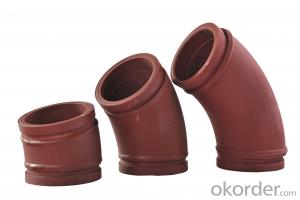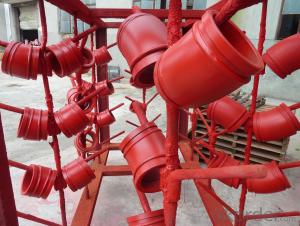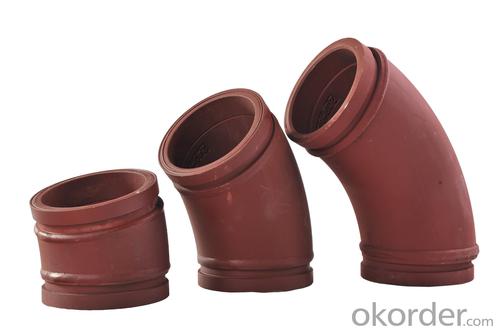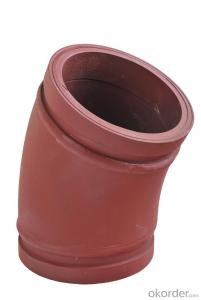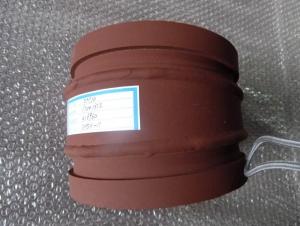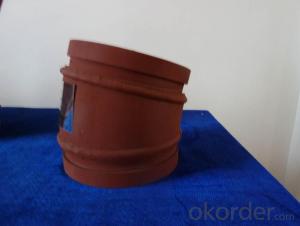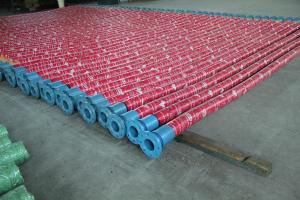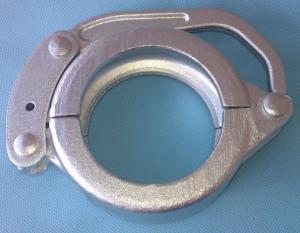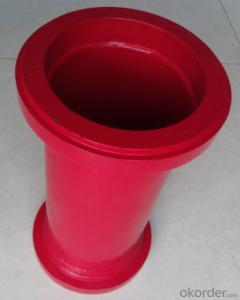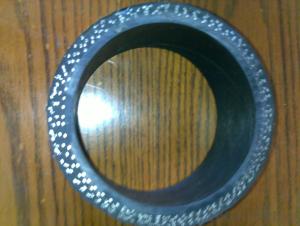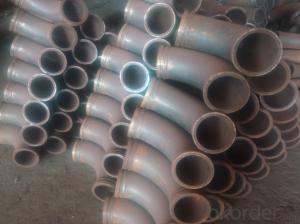Twin Wall Elbow for Concrete Pump R275 45DGR
- Loading Port:
- Tianjin
- Payment Terms:
- TT OR LC
- Min Order Qty:
- 80 pc
- Supply Capability:
- 5000 pc/month
OKorder Service Pledge
OKorder Financial Service
You Might Also Like
Twin Wall Elbow (Twin Wall Flange)
(1) Material: Q235 (outside) + GCr15(inside)
(2) Thickness: 3mm (outside) + 9mm (inside)
(3) Technology: Quenching under high temperature
(4) Characteristics: the inner rigidity to 63 HRC; the outside has so high toughness to keep the inner.
(5) Matched with: Twin wall flange, Alloy (GCr15) + 20#
(6) Working Pressure:170bar
(7) Service life: above 60,000 cubic meters.
(8) Package: PP woven bag and plastic cap
Twin wall elbow is created with research of us and need of the market. Its service life and working pressure are better than the casting. Besides, We can supply 90D, 45D, 30D, 25D, 20D, 15D, 10D. And it can be used for PM, JUNJIN, Schwing, Cifa, Sany, ect.
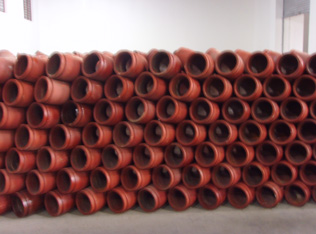
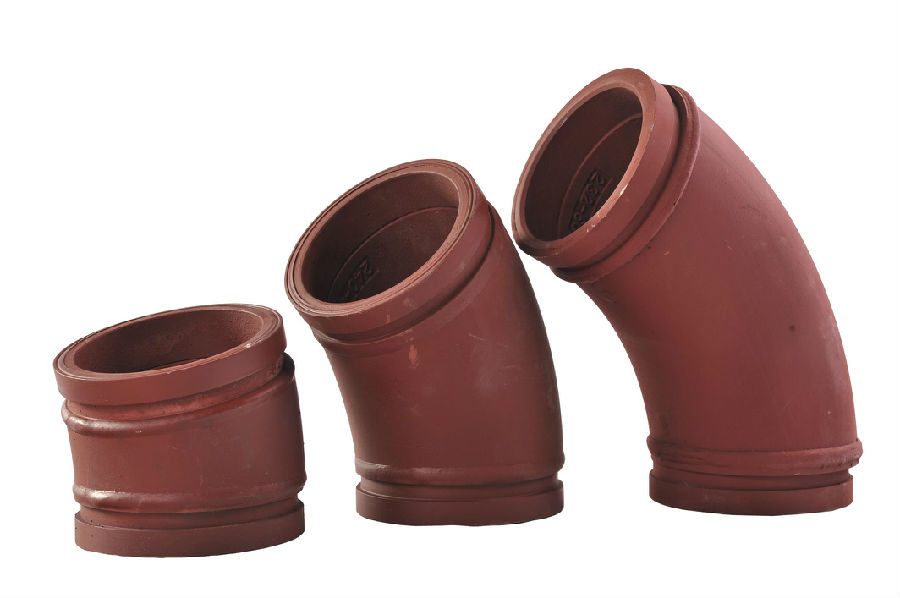
- Q: Are there any specific guidelines for the installation of pistons or cylinders in concrete pump spare parts?
- Yes, there are specific guidelines for the installation of pistons or cylinders in concrete pump spare parts. These guidelines are important to ensure proper functioning and longevity of the equipment. 1. Clean and inspect: Before installing pistons or cylinders, it is crucial to thoroughly clean and inspect them for any damage or defects. Any debris or contaminants should be removed to prevent potential issues during operation. 2. Lubrication: Apply a suitable lubricant to the piston or cylinder to reduce friction and ensure smooth movement. This will also help in preventing wear and tear, enhancing the lifespan of the parts. 3. Alignment: Proper alignment of the piston or cylinder is essential. Ensure that the piston is aligned correctly with the cylinder bore to avoid any binding or excessive wear. This can be achieved by following the manufacturer's instructions or consulting a professional if necessary. 4. Torque specifications: It is important to tighten the bolts or fasteners according to the manufacturer's recommended torque specifications. Over-tightening or under-tightening can lead to problems such as leaks or mechanical failure. 5. Sealing: Use appropriate sealing materials, such as gaskets or O-rings, to ensure a proper seal between the piston and cylinder. This will prevent fluid leakage and maintain the efficiency of the equipment. 6. Testing: After installation, it is recommended to test the pistons or cylinders to ensure they are functioning correctly. This can involve performing a trial run or conducting pressure tests to check for any leaks or abnormalities. Following these guidelines will help ensure the proper installation of pistons or cylinders in concrete pump spare parts, leading to reliable and efficient operation of the equipment. It is always advisable to refer to the manufacturer's instructions or seek professional assistance if there are any doubts or concerns during the installation process.
- Q: Can concrete pump spare parts be coated with UV-resistant coatings for outdoor applications?
- Yes, concrete pump spare parts can be coated with UV-resistant coatings for outdoor applications. These coatings provide protection against the harmful effects of ultraviolet rays, preventing damage and extending the lifespan of the parts when exposed to sunlight.
- Q: How do I identify the right spare part for my concrete pump model?
- If you want to find the correct spare part for your concrete pump model, there are several steps you can take: 1. Begin by referring to the manufacturer's manual. This manual is a great starting point because it typically contains detailed information about your concrete pump model and the corresponding spare parts. Look for part numbers, descriptions, and any specific instructions regarding ordering or replacing parts. 2. Conduct online research. Utilize the internet to search for your specific concrete pump model and related spare parts. Many manufacturers have official websites or authorized distributors that provide product catalogs or online databases where you can search for the exact part you need. Look for compatibility charts or diagrams that match your concrete pump model with the appropriate spare parts. 3. Seek advice from a specialist. If you are uncertain about the compatibility or availability of spare parts for your concrete pump model, it is advisable to consult with a specialist. Reach out to the manufacturer's customer service or contact a local distributor or service center that specializes in concrete pumps. Provide them with details about your pump model and the specific part you require, and they should be able to assist you in identifying the correct spare part. 4. Speak with other concrete pump owners. Get in touch with other owners or operators of concrete pumps who have the same or a similar model as yours. They may have experience with finding and replacing spare parts and can offer recommendations or tips on where to search or who to contact. Remember, it is vital to ensure that the spare part you select is compatible with your concrete pump model to prevent any damage or malfunctions. Taking the time to conduct research and seek advice from experts will help you find the appropriate spare part and keep your concrete pump operating smoothly.
- Q: How often should concrete pump control boxes be inspected and replaced?
- To maintain proper functioning and safety, it is essential to regularly inspect the control boxes of concrete pumps. The frequency of inspections and replacements will vary depending on factors such as pump usage, operating conditions, and manufacturer recommendations. In general, it is advisable to inspect the control box at least once a year or according to the manufacturer's guidelines. However, if the concrete pump is extensively used or exposed to harsh conditions, more frequent inspections may be needed. This involves checking electrical connections, switches, buttons, and indicators for signs of wear, damage, or malfunction. Moreover, inspections should be conducted after significant maintenance or repairs on the pump, as well as following any incidents or accidents. Regular inspections allow for early identification of potential issues, enabling timely repairs or replacements and reducing the risk of breakdowns or accidents. When it comes to replacements, control boxes should be replaced if they cannot be repaired or if they are outdated and no longer meet safety standards. It is important to consult the manufacturer or a qualified professional to determine the appropriate replacement schedule based on the specific conditions and usage of the concrete pump. Always remember, regular inspections and timely replacements of concrete pump control boxes are essential for ensuring the safe and efficient operation of the equipment.
- Q: What are the different types of concrete pump hydraulic pumps?
- There are two main types of concrete pump hydraulic pumps: the piston pump and the gear pump. The piston pump uses reciprocating pistons to generate pressure and move the concrete, while the gear pump uses rotating gears to pump the concrete. Both types have their own advantages and are suitable for different applications.
- Q: How do I properly maintain and replace rubber pistons in concrete pump spare parts?
- To guarantee efficient pump operation and extend equipment lifespan, it is imperative to maintain and replace rubber pistons in concrete pump spare parts. Below are guidelines for proper maintenance and replacement: 1. Regularly Inspect: Regularly examine the rubber pistons to detect any wear or damage. Look for visible signs of deterioration such as cracks, tears, or other forms of degradation. 2. Thorough Cleaning: Prior to replacing the rubber pistons, thoroughly cleanse the surrounding area. Remove any dirt, debris, or concrete residue that may be present. This will prevent contamination and ensure a proper fit for the new pistons. 3. Adequate Lubrication: Apply a suitable lubricant to the rubber pistons to guarantee smooth operation and reduce friction. This will prolong the pistons' lifespan and prevent premature wear. 4. Proper Installation: When replacing the rubber pistons, ensure correct installation in accordance with the manufacturer's instructions. Utilize appropriate tools and techniques to avoid damaging the pistons or other pump components. 5. High-Quality Replacement Parts: Always opt for reputable suppliers and utilize high-quality replacement rubber pistons. Inferior quality pistons may not perform optimally and could result in frequent replacements or pump damage. 6. Regular Maintenance: Establish a regular maintenance schedule for your concrete pump, including the rubber pistons. This may involve cleaning, lubrication, and inspection of the pistons to identify potential wear or damage before they become major issues. 7. Training and Expertise: Ensure that the individual responsible for maintaining and replacing the rubber pistons possesses the necessary training and expertise. This will ensure proper execution of the task and minimize the risk of pump damage or personnel injury. By adhering to these guidelines, you can effectively maintain and replace rubber pistons in concrete pump spare parts, thereby ensuring optimal equipment performance and longevity.
- Q: How can the concrete pump pipe be cleaned?
- The pipeline shall be provided with a stop valve, and the stop plate shall be inserted to prevent the vertical or upward tilting of the concrete in the pipe
- Q: What is the function of a concrete pump hydraulic accumulator?
- A concrete pump hydraulic accumulator serves a crucial function in the operation of a concrete pump. Its main purpose is to store and release hydraulic energy, which helps in maintaining a constant and smooth flow of concrete during pumping operations. The hydraulic accumulator acts as a pressure storage tank that is connected to the hydraulic system of the concrete pump. When the pump is not in operation, the accumulator stores pressurized hydraulic fluid. This stored energy can be released when required, such as during the pumping process, providing an additional power source to supplement the main hydraulic system. During concrete pumping, the accumulator assists in maintaining a consistent flow of concrete by compensating for pressure fluctuations in the hydraulic system. It serves as a buffer, absorbing any excess pressure and releasing it back into the system when needed. This helps in preventing pressure spikes or drops, which could otherwise lead to irregular concrete flow or even damage to the pump. Furthermore, the hydraulic accumulator also plays a role in reducing energy consumption and enhancing the overall efficiency of the concrete pump. By storing and reusing energy, it minimizes the need for constant power supply from the main hydraulic system, thereby reducing the load on the pump's engine and improving fuel efficiency. Overall, the function of a concrete pump hydraulic accumulator is to store and release hydraulic energy, ensuring a consistent and smooth flow of concrete during pumping operations, while also contributing to energy efficiency and protecting the pump from potential damage.
- Q: What are the different types of concrete pump rubber pistons?
- There are generally two types of concrete pump rubber pistons: single-layer pistons and double-layer pistons. Single-layer pistons are made of a single piece of rubber and are commonly used for small to medium-sized concrete pumps. On the other hand, double-layer pistons have an additional layer of fabric or wire mesh embedded within the rubber, providing increased durability and strength. These double-layer pistons are typically used for larger concrete pumps and heavy-duty applications.
- Q: What are the signs of a worn-out concrete pump piston?
- There are multiple indicators that can suggest a worn-out concrete pump piston. Initially, a decrease in output or performance may signify this issue. Reduced pumping pressure or slower pumping speed can be observed as a result of this decline in performance. Another indication of a worn-out piston in a concrete pump is increased leakage. If you notice an excessive amount of hydraulic oil or water leaking from the pump, it could be an indication that the piston is no longer effectively sealing. This leakage can also lead to contamination of the hydraulic fluid, which can cause additional harm to the pump components. Furthermore, an irregular concrete flow can be caused by a worn-out piston. If you notice inconsistent and uneven delivery of concrete, such as pulsating or surging flow, it may be due to an uneven wear pattern on the piston. This can have a detrimental effect on the quality of the concrete and the overall efficiency of the pumping operation. Additionally, excessive vibration and noise during the pumping process can also suggest a worn-out piston. Vibrations may occur as a result of the piston not moving smoothly within the cylinder, leading to friction and noise. These vibrations and noises can also indicate other underlying problems with the pump, so it is important to address them promptly. Finally, a visual inspection can provide valuable information regarding the condition of the concrete pump piston. Physical damage, such as cracks or excessive wear on the piston surface, are clear indications of a worn-out piston. These damages can be caused by abrasive materials or harsh operating conditions. In conclusion, if you observe any of these signs or suspect that your concrete pump piston is worn-out, it is crucial to have it inspected and replaced by a professional. Timely maintenance and replacement of worn-out pistons can prevent further damage to the pump and ensure a smooth and efficient operation.
Send your message to us
Twin Wall Elbow for Concrete Pump R275 45DGR
- Loading Port:
- Tianjin
- Payment Terms:
- TT OR LC
- Min Order Qty:
- 80 pc
- Supply Capability:
- 5000 pc/month
OKorder Service Pledge
OKorder Financial Service
Similar products
Hot products
Hot Searches
Related keywords
